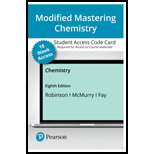
Concept explainers
(a)
Interpretation:
The oxidation state of oxygen in each oxide and the oxidation state of the other element should be determined.
Concept introduction:
Oxygen has six valence electrons in its valence shell, therefore, oxygen can achieve an octet by accepting two electrons from an active metal or by sharing two additional electrons through covalent bonding.
When oxygen reacts with active metals, it gives ionic oxides. With nonmetals, oxygen forms covalent oxides.
All the oxygen in oxides are in
(b)
Interpretation:
Each oxide should be identified as molecular or a solid with an infinity extended three-dimensional structure
Concept introduction:
Oxygen has six valence electrons in its valence shell, therefore, oxygen can achieve an octet by accepting two electrons from an active metal or by sharing two additional electrons through covalent bonding.
When oxygen reacts with active metals, it gives ionic oxides. With nonmetals, oxygen forms covalent oxides.
(c)
Interpretation:
The oxides which are likely to be a gas or a liquid and which are likely to be a high-melting solid should be determined.
Concept introduction:
Most of ionic oxides form crystal lattice structures. Lattice energies are very high, so, the bonds between atoms are difficult to break. So, ionic oxides have higher melting points. Most first row and second row nonmetal oxides have lower melting points, so, most of them exists as gas or liquid at room temperature.
(d)
Interpretation:
The identity of the other element in (2) and (3) should be determined.
Concept introduction:
Oxygen has six valence electrons in its valence shell, therefore, oxygen can achieve an octet by accepting two electrons from an active metal or by sharing two additional electrons through covalent bonding.
When oxygen reacts with active metals, it gives ionic oxides. With nonmetals, oxygen forms covalent oxides.
Want to see the full answer?
Check out a sample textbook solution
Chapter 22 Solutions
CHEMISTRY-MOD.MASTERING (18W)
- Indicate the products obtained by mixing 2,2-dimethylpropanal with acetaldehyde and sodium ethoxide in ethanol.arrow_forwardSynthesize 2-Ethyl-3-methyloxirane from dimethyl(propyl)sulfonium iodide using the necessary organic or inorganic reagents. Draw the structures of the compounds.arrow_forwardSynthesize 2-Hydroxy-2-phenylacetonitrile from phenylmethanol using the necessary organic or inorganic reagents. Draw the structures of the compounds.arrow_forward
- Synthesize N-Methylcyclohexylamine from cyclohexanol using the necessary organic or inorganic reagents. Draw the structures of the compounds.arrow_forwardSynthesize N-Methylcyclohexylamine from cyclohexanol using the necessary organic or inorganic reagents. Draw the structures of the compounds.arrow_forwardIf possible, please provide the formula of the compound 3,3-dimethylbut-2-enal.arrow_forward
- Synthesize 1,4-dibromobenzene from acetanilide (N-phenylacetamide) using the necessary organic or inorganic reagents. Draw the structures of the compounds.arrow_forwardIndicate the products obtained by mixing (3-oxo-3-phenylpropyl)triphenylphosphonium bromide with sodium hydride.arrow_forwardWe mix N-ethyl-2-hexanamine with excess methyl iodide and followed by heating with aqueous Ag2O. Indicate the major products obtained.arrow_forward
- Indicate the products obtained by mixing acetophenone with iodine and NaOH.arrow_forwardIndicate the products obtained by mixing 2-Propanone and ethyllithium and performing a subsequent acid hydrolysis.arrow_forwardIndicate the products obtained if (E)-2-butenal and 3-oxo-butanenitrile are mixed with sodium ethoxide in ethanol.arrow_forward
 Chemistry & Chemical ReactivityChemistryISBN:9781337399074Author:John C. Kotz, Paul M. Treichel, John Townsend, David TreichelPublisher:Cengage Learning
Chemistry & Chemical ReactivityChemistryISBN:9781337399074Author:John C. Kotz, Paul M. Treichel, John Townsend, David TreichelPublisher:Cengage Learning Chemistry & Chemical ReactivityChemistryISBN:9781133949640Author:John C. Kotz, Paul M. Treichel, John Townsend, David TreichelPublisher:Cengage Learning
Chemistry & Chemical ReactivityChemistryISBN:9781133949640Author:John C. Kotz, Paul M. Treichel, John Townsend, David TreichelPublisher:Cengage Learning Chemistry: Principles and PracticeChemistryISBN:9780534420123Author:Daniel L. Reger, Scott R. Goode, David W. Ball, Edward MercerPublisher:Cengage Learning
Chemistry: Principles and PracticeChemistryISBN:9780534420123Author:Daniel L. Reger, Scott R. Goode, David W. Ball, Edward MercerPublisher:Cengage Learning Chemistry: An Atoms First ApproachChemistryISBN:9781305079243Author:Steven S. Zumdahl, Susan A. ZumdahlPublisher:Cengage Learning
Chemistry: An Atoms First ApproachChemistryISBN:9781305079243Author:Steven S. Zumdahl, Susan A. ZumdahlPublisher:Cengage Learning ChemistryChemistryISBN:9781305957404Author:Steven S. Zumdahl, Susan A. Zumdahl, Donald J. DeCostePublisher:Cengage Learning
ChemistryChemistryISBN:9781305957404Author:Steven S. Zumdahl, Susan A. Zumdahl, Donald J. DeCostePublisher:Cengage Learning Chemistry: Principles and ReactionsChemistryISBN:9781305079373Author:William L. Masterton, Cecile N. HurleyPublisher:Cengage Learning
Chemistry: Principles and ReactionsChemistryISBN:9781305079373Author:William L. Masterton, Cecile N. HurleyPublisher:Cengage Learning





